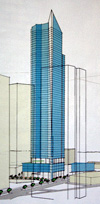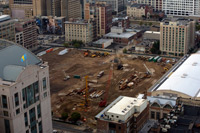18 September 08: The Possible City
Dwindling/rekindling possibilities?
 by Nathaniel Popkin September 18, 2008 Ed. note: Nathaniel has an excellent, intriguing piece on Nicaragua for Naked City in the new City Paper. It is online HERE. Also, in this piece, he mentions The Skinny -- its information will be updated and added onto in the coming days. The ripping apart and reassembling has been going for as long as some people can remember, and still it goes. Bainbridge where I live is sliced open; a line of black asphalt snakes through the neighborhood like a cold alpine creek and men heave and dig and fire generators and wicked two-stroke engines. The noise endemic, the air, even on a day like today so shatteringly crisp is cluttered with particulates and low, near the earth itself -- baby carriage height -- it must be toxic. The creek snakes south, but just north the surgery on South Street, the cheeky red light district, is near completion. I don't complain about this project. The sidewalk's smooth now and the lighting better and it's been followed by the opening of a handful of decent new stores. My only concern is the glaring one illuminated by Tom Ferrick in one of his last Inquirer columns: there are too few African-Americans working on this union job. Meanwhile at 6th and South artists complete the new mural dedicated to African-American firemen (really a nod to the neighborhood's powerful black history). The failure to integrate our trade unions can't be overstated. But so many have indeed participated on a scale not seen in at least a generation. Imagine the human energy spent remaking this city these past ten years. Imagine the will. The Skinny lists 24 major projects "complete." Of course that's merely a hint of what's taken place. On certain blocks across the city every rowhouse has been renovated, updated, improved. Vast infrastructure has been replaced, universities and other institutions expanded, the airport and other transit nodes expanded, parks replenished. All this, the rush of it, the filth and sweat (never mind what's getting built), combined with the torrid energy of the foreign born, is dazzling, and it feels good. And now, says, Inga Saffron in last Friday's Inquirer, facing down financial crisis and burst bubble, "Philadelphia's greatest real-estate boom in half a century has come and gone."  What's now: one by one the best proposals have fallen away. A few, some gems, some duds -- the Parkway Central Library expansion, the Barnes, Penn's eastward
expansion, the Philadelphia Museum, the expansion of the Convention Center, a casino or two -- are likely to happen. That's critical, of course. The end isn't
near. Our imaginations will keep fire.
What's now: one by one the best proposals have fallen away. A few, some gems, some duds -- the Parkway Central Library expansion, the Barnes, Penn's eastward
expansion, the Philadelphia Museum, the expansion of the Convention Center, a casino or two -- are likely to happen. That's critical, of course. The end isn't
near. Our imaginations will keep fire.But the brilliant momentum that spawned The Skinny, and the joy of watching the list grow, day after day for four years, is gone. (It may be useful to expand the vision of the Skinny somewhat to include more infrastructure projects, more schools -- the School District has an ambitious capital program -- more institutional projects large and small. Paying attention to these smaller-scale investments, in part to ensure their quality, is a way to keep us engaged in the constant reweaving of the urban fabric.) The near-term possibilities, certainly, have dwindled. We are fortunate to have strong leadership (imagine if it had only accompanied the boom). And yet there is worry, and there ought to be. The current financial crisis acts like an Internet virus, and its still spreading. Pain is coming, perhaps well beyond the red ink already encountered by the city's budget office. Present levels of immigration seem unsustainable, and violent crime persists. Though the police department reports a 17% drop in shootings this year from last, armed men still retain a hold on certain vast neighborhoods. Writing in this month's Harper's, where he is contributing editor, novelist (and former captain of the Penn basketball team) John Edgar Wideman says of this persistent state, which he likens to the state of war: a war keeping people locked down at home, no foreign enemies to defeat, just ourselves defeated by fear of one another, a war incarcerating all of us in killing fields . . .Indeed, it's begun to feel like someone else's freedom -- one gun a month just won't do -- has become our urban prison, and Philadelphia a hellfire for a couple thousand victims a year. If homicide had already undercut the boom, imagine how it plays in a downturn, with a shrinking tax base, a federal government distracted by crisis and war, and deepening poverty. In his forthcoming magisterial work on civil rights in the north, Sweet Land of Liberty (Random House, on sale November 4) Penn historian Tom Sugrue reminds us of just how this went down in the 1970s: Cities struggled mightily with declining tax revenue at the same time that poverty was rising and infrastructure was decaying. One important stopgap had been the infusion of federal funding to city government between the New Deal and the early 1970s. But beginning in the 1970s, as central cities grew blacker and poorer, the federal government began a steady withdrawal of urban funding.All this is the source of our present trouble -- and quite eerily what we're about to face again. But there are significant differences, not the least of which is a possible Obama presidency. Whereas the anti-urban Jimmy Carter became a Democratic president at a similar moment in the period Sugrue describes, the Chicago senator is an urbanite, who lives in what might be Spruce Hill, Hyde Park. His platform promises a national director of urban affairs and an infrastructure investment fund; critically, he seems to understand that cities are particularly important to the wealth and health of a nation. High gas prices and global warming have already elevated the status of public transit; infrastructure is therefore already getting a boost. It may be crumbling, but at least now we're paying attention. And so long as Governor Rendell can protect SEPTA's dedicated funding, the agency will continue to aspire to something greater. With only two years to go in the Rendell administration, his leadership is key to surviving this current crisis. Can the governor, that greatest of all Philly cheerleaders, immunize us from decline? No, but smart investment by Harrisburg in transformative projects can propel the city, just as, as a matter of psychology, the convention center and all the hotels did in the 1990s. These two years are certainly a last great hope for progressive, urban-oriented policy-making.  There is, of course, a massive, transformative state-funded project awaiting, the convention center expansion. Unfortunately, it seems both out of the hands of
the governor and the mayor, and not just for this, I am worried. Might that project, already well over budget and behind schedule, collapse? Mind you, I am
conjecturing, so don't panic; on the other hand, can't you just picture that vast empty lot, now freed of its interesting, panoptic architecture, a giant black
top? It's Saffron's worst nightmare -- and ours. Mayor Nutter ought to get control of the project, which now seems to operate in a black hole, illuminate the
process and assert real management (much as he inserted the city back into the casino process). I'm not opposed to convention centers -- my sense is that most
anything that makes a city feel open to the rest of the world is valuable -- but I haven't confidence in this project. Its loss would be wounding.
There is, of course, a massive, transformative state-funded project awaiting, the convention center expansion. Unfortunately, it seems both out of the hands of
the governor and the mayor, and not just for this, I am worried. Might that project, already well over budget and behind schedule, collapse? Mind you, I am
conjecturing, so don't panic; on the other hand, can't you just picture that vast empty lot, now freed of its interesting, panoptic architecture, a giant black
top? It's Saffron's worst nightmare -- and ours. Mayor Nutter ought to get control of the project, which now seems to operate in a black hole, illuminate the
process and assert real management (much as he inserted the city back into the casino process). I'm not opposed to convention centers -- my sense is that most
anything that makes a city feel open to the rest of the world is valuable -- but I haven't confidence in this project. Its loss would be wounding.Post-boom, the administration will want to pay more attention to the educational and medical institutions -- the "Eds and Meds" as former LaSalle University professor Rick Geruson called them in the early 1990s -- that form the backbone of the city's economy. Several of those institutions will continue expanding, with some intent on also improving the neighborhoods where they are located. Because there is already momentum these nodes might be useful magnets for more intensive planning and investment on the part of the administration. An Eds and Meds -- and some now ad arts and culture -- strategy will help make the investment of scarce resources resonate. Related, I might seek alternative ways to go about neighborhood investment. Historic preservation is at present an under-utilized tool (indeed, the opposite, historic destruction, seems to prevail); the Preservation Alliance would like to commence a preservation plan for the entire city. It ought to be funded, turning, at long last, our architectural heritage into real city-wide potential. At the same time, progressive, contemporary architecture will need life support during a downturn. Why not initiate a design-build competition on some piece of open, but central land (perhaps one of our parking lot entrepreneurs would make a donation)? Chicago, with its fortunes teetering the early 1990s, did so; a new Chicago school was born. (And residential architecture there avoided the reactionary pitfall we're forced to look at everyday.) Perhaps the greatest loss in downturn is the feeling of moving ever forward. Men and women in hardhats amplify this city's resilience. It feels like a fight back. Lose them, and? Historian Shan Holt, now the director of the Sandy Spring Museum in Maryland, lends us another way to think about it. She says Philadelphia's historic strength and source of its contemporary energy is how the city performs as a Petri dish, an R&D center at the street level. This, more than giant projects like Comcast Center, is the source of our present optimism. So many of us are engaged in so many kinds of vital initiatives; here is the energy to propel us forward. Let's keep experimenting. –Nathaniel Popkin nathaniel.popkin@gmail.com For more on The Possible City, please see HERE. For Nathaniel Popkin archives, please see HERE, or visit his web site HERE. |
|
• 26 August 08: TPC, NOW AVAILABLE IN PAPERBACK • 26 June 08: The Mother of Invention • 29 Apr 08: "This is not pie-in-the-sky" • 1 Apr 08: Recess/Re-assess • 7 Mar 08: One-City Art Movement, Open to Everyone • 24 Feb 08: Too late for the streetscape? • 15 Feb 08: "It really could be something." • 18 Jan 08: Estuary of Dreams • 11 Jan 08: More than shelter • 10 Jan 08: Nature's balance • 6 Dec 07: Snake uprising • 4 Dec 07: A Junction that ought to be • 6 Nov 07: Around the Mulberry Tree we go • 29 Oct 07: Wondering about wandering • 5 Oct 07: No other way • 21 Sept 07: Here is the Possible City |
